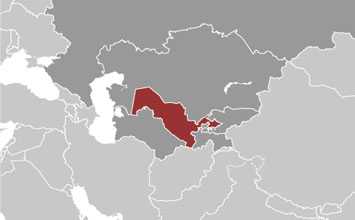
CDC has a long history of collaboration with Uzbekistan to better recognize and respond to public health threats. In 2003, CDC established its office in Uzbekistan to assist in modernizing national infectious disease surveillance systems, improving the country capacity in performing sound health policy analysis, and identifying updated control measures for important infectious diseases.
Download Overview Fact Sheet
 Staff
Staff
CDC office (physical presence)
No Assignees
5 Locally Employed
 Uzbekistan at a Glance
Uzbekistan at a Glance
Population: 29,779,600
Per capita income: $2,910
Life expectancy at birth women/men: 73/75 yrs
Infant mortality rate: 44/1000 live births
Population Reference Bureau World Population Data Sheet, 2011
 Top 10 Causes of Death
Top 10 Causes of Death
Source: GBD Compare, 2010
- Ischemic heart disease 32%
- Stroke 15%
- Cancer 8%
- Lower respiratory infections 8%
- Cirrhosis 5%
- Neonatal Encephalitis 3%
- Road injuries 3%
- Diabetes 2%
- Chronic obstructive pulmonary disease 2%
- Tuberculosis 2%
What CDC Is Doing
- Page last reviewed: March 27, 2014
- Page last updated: March 27, 2014
- Content source:
Global Health
Notice: Linking to a non-federal site does not constitute an endorsement by HHS, CDC or any of its employees of the sponsors or the information and products presented on the site.



 ShareCompartir
ShareCompartir

 The CDC office in Uzbekistan provides support to MOH professionals in strengthening their HIV prevention, and care and treatment programs as well as their health systems capacity. The CDC office provides technical assistance in strengthening public health systems in the country by focusing on the provision of strategic information, injection safety, care and treatment services, and prevention for at-risk and vulnerable populations.
The CDC office in Uzbekistan provides support to MOH professionals in strengthening their HIV prevention, and care and treatment programs as well as their health systems capacity. The CDC office provides technical assistance in strengthening public health systems in the country by focusing on the provision of strategic information, injection safety, care and treatment services, and prevention for at-risk and vulnerable populations.